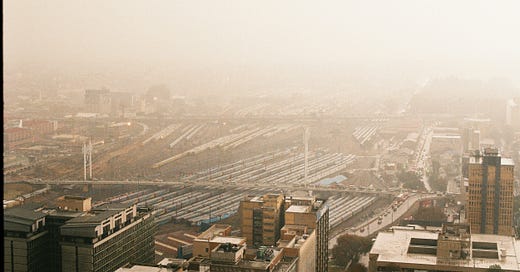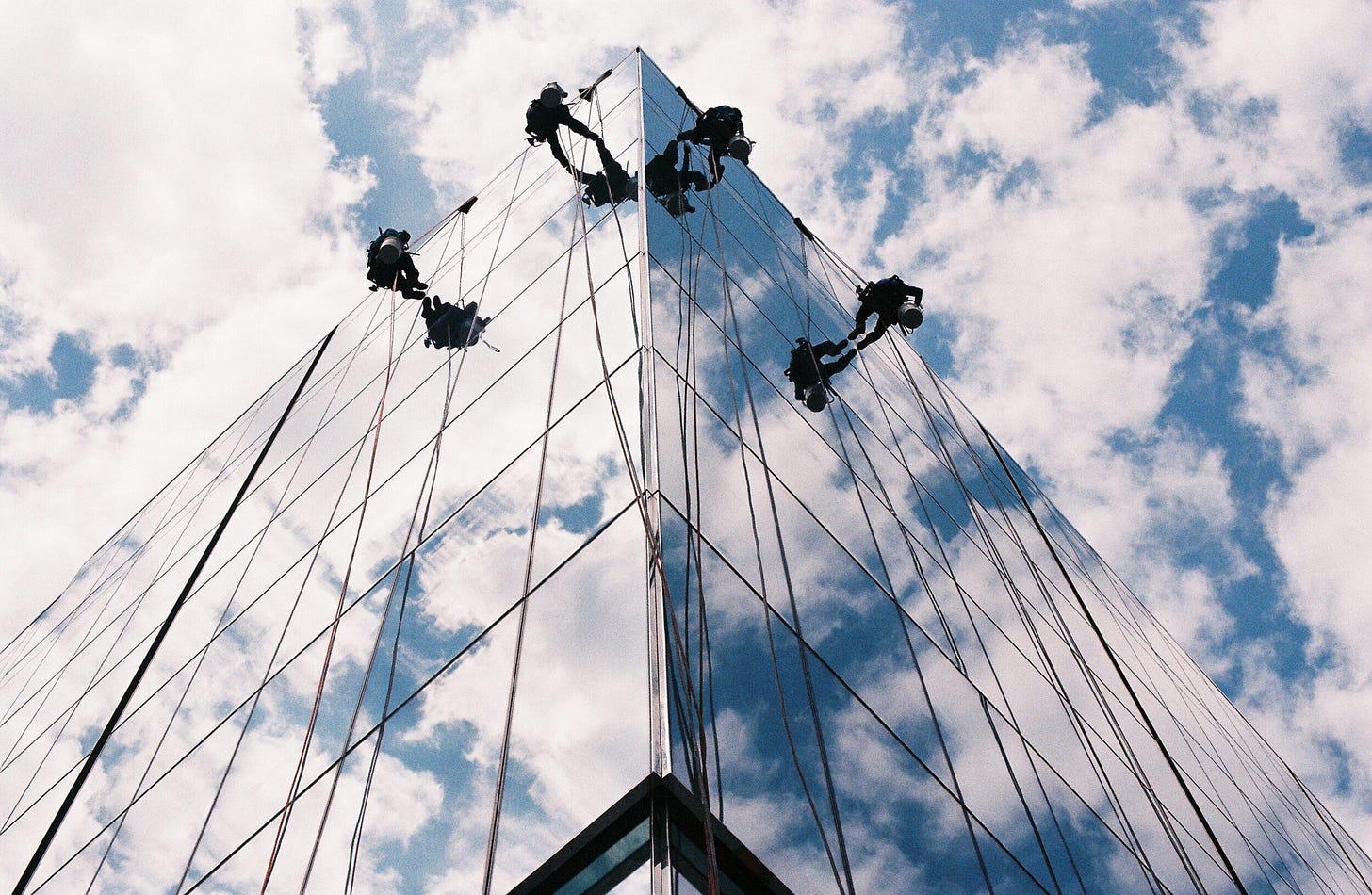The mist and the distance: it is difficult to approach the photograph except as a metaphor on what is vast and limitless. In the foreground, buildings are seen from above, and looking farther into the frame, the line of a bridge marks the border of the background. On that bridge, cars are arranged like a line of ants, mottled like matchboxes. Distance is the destination, what separates land from sky, above from below. The air gathers in the sepia-toned mist, the skyscrapers rise into slender monuments. And the awe is in how vast a city can seem, its occupants as if invisible.
Lidudumalingani: “I’m about beauty first.”
The photograph was taken in Braamfontein, Johannesburg, South Africa.
This is one of those classic Joburg weather days. Summer, but very much unlike summer, instead gloomy, wet and cold. I don’t recall exactly the time of day when the photograph was taken, but from the congested traffic, the direction of the light source, I am going to go with morning. Every morning is like this in the city, commuters trying to get to work, the road a contested city infrastructure.
From the balcony I framed the image from, on the 27th floor of the apartment, I had the view of the park station, and above it, Mandela Bridge, then the trains stretching on, which is in the picture. I was immediately drawn to the different modes of transport. The taxis, the bus, the private cars and the trains. In the photograph, the trains in the foreground are long distance trains, Shosholoza Meyl, and in the background, in striking yellow are commuter trains, Metrorail. Not far from the trains, off the building in the foreground of the image, is Park Station, the largest railway station in Africa, where short and long distance trains ferry customers. The first railway line ran in 1888, and since then, Park Station has seen many upgrades and renovations, and rebuilds. On 5 July 1913, the station was burnt down during a protest by mine workers from sixty-three mines across the city. I see all of this in this photograph, a palimpsest of history that is centuries apart, existing in a single image.
I’m interested in Johannesburg as a migrant city and how in becoming a metropolis it cannot shake off being a migrant city. This image, these train tracks, these trains, remind me of the arrival of all the mine workers who came to work in the mines around the city in the 1800s. It reminds me of my own father, whom as a young boy, came here to work in the mines.
All of this historical stuff is wonderful, but before the digging of history, my photographs are concerned with beauty. I’m about beauty first. Then the digging of history, the connection of the past and the present follows. The beauty in this photograph is the quiet and isolation that exists in this chaos. It’s the intensity and tension. It’s the mist that glazes everything in this delicate and natural filter.
This is, damnit, going to sound pretentious and elusive, but I think that a good photograph needs no thinking, no justification. The viewer must love a photograph without thinking. And then love it more after thinking. Or hate it.
During the December holidays I went home to the Eastern Cape, and spent some time making photographs of missionary history in the Eastern Cape. The best photo I’ve taken is of an old stone at a church built in 1875. That simple photograph opens up thousand years of history, travels through colonialism, to modern Christianity. I think that’s impactful. A story of centuries condensed into a single frame.
Two other photographs by Lidudumalingani
For each week’s feature, I send 3 photographs to the photographer, and ask them to respond to one. Here are the 2 other photographs I selected from Lidudumalingani’s portfolio and sent to him. What do you think about any of them? You can respond as a comment below.
What to Read
Lidudumalingani is also a wonderful, astute writer. This week, I’m reading two of his essays on photography. On Winnie Mandela’s portraits: “If this portrait, curated from our views of her, does not look like this, a woman who is slightly beyond the grasp of our thinking, it has failed to capture her.”
And, on Santu Mofokeng’s photographs as a visual metaphor for Johannesburg. “Of the many images that are being made in Johannesburg every day, by its throngs of photographers and citizens, none will ever capture the elusiveness of the city, its spirituality and its complexities, the way his photographs did.”
Thank you for reading and sharing this feature on Lidudumalingani. You can see more of his work on his website, and on Instagram.
Every week I feature one photograph and the photographer who took it. You’ll read a short caption from me, and a statement from the photographer. My goal is to set up conversations with the work of early to mid-career African photographers. You can support the newsletter by asking someone—or 10 people!—to subscribe.







